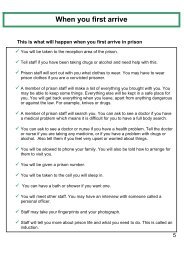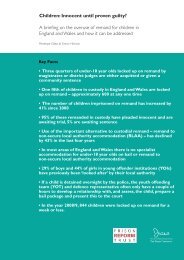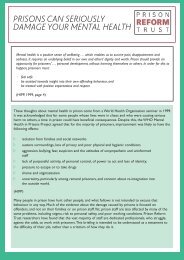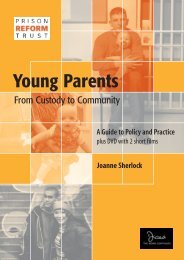Mothers and fathers in custody, prisoners’ childrenHome Office research has found that 66%of women in prison have dependentchildren under 18. Of those, 34% hadchildren under 5, a further 40% children agedfrom 5 to 10. 132 Each year it is estimated thatmore than 17,700 children are separated fromtheir mother by imprisonment.Just 5% of women prisoners’ children remainin their own home once their mother hasbeen sentenced. 133At least a third of mothers are lone parentsbefore imprisonment. 134Only half of the women who had lived, orwere in contact with, their children prior toimprisonment had received a visit sincegoing to prison. 135One Home Office study showed that for85% of mothers, prison was the first timethey had been separated from their childrenfor any significant length of time. 136An ICM public opinion poll, commissionedby SmartJustice in March 2007, found that,of 1,006 respondents, almost three quarters(73%) thought that mothers of youngchildren should not be sent to prison fornon-violent crime. 137There are 84 places in mother and babyunits in prisons reserved for mothers whohave children under the age of 18 months.In 2004, 114 women gave birth while servinga prison sentence. 138There are currently 39 children in motherand baby units. 139HM <strong>Prison</strong>s Inspectorate has found that 25% ofwomen prisoners had their children’s father ora spouse or partner caring for their children.25% were cared for by their grandmothers; 29%were cared for by other family members or friendsand 12% were in care, with foster parents, or hadbeen adopted. 140In 2004, for the first time the governmentannounced that a record will be kept ofprisoners’ children. Information will be recordedon the National Offender Management InformationSystem. 141 This commitment has yet to beimplemented due to IT systems failure.Just over half (55%) of male prisoners describedthemselves as living with a partner beforeimprisonment 142 and a third of female prisonersdescribed themselves as living with a husbandor partner before imprisonment. 143Research has found that 59% of men 144 inprison and two-thirds of women in prison havedependent children under 18. 145It is estimated that every year150,000 childrenhave a parent in prison. During their time atschool 7% of children experience their father’simprisonment. 146<strong>Prison</strong>ers’ families, including their children,often experience increased financial, housing,emotional and health problems during asentence. Nearly a third (30%) of prisoners’children suffer significant mental health problems,compared with 10% of the general population. 147132. Home Office Research Study 208133. <strong>Prison</strong> <strong>Reform</strong> <strong>Trust</strong> (2000) Justice for Women: The Need for <strong>Reform</strong>, London: <strong>Prison</strong> <strong>Reform</strong> <strong>Trust</strong>134. Social Exclusion Unit (2002) Reducing re-offending by ex-prisoners, London: Social Exclusion Unit 135. Ibid.136. Home Office Research Study 162 (1997), Imprisoned Women and Mothers, Home Office: London137. SmartJustice (2007) ‘Public say: stop locking up so many women’.138. Hansard, House of Commons written answers, 13 July 2005 139. Hansard, House of Commons written answers, 19 June 2007140. HM <strong>Prison</strong>s Inspectorate (1997) Women in <strong>Prison</strong>: A Thematic Review by HM Chief Inspector of <strong>Prison</strong>s for England and Wales, London: Home Office141. Hansard, House of Commons written answers, 12 September 2004 142. Home Office (2001) Criminality Survey: Drugs Follow-Up, London: Home Office143. Hamlyn, B. and Lews, D. (2000) Women prisoners: a survey of their work and training experiences in custody and on release, Home Office Research Study2000, London: Home Office144. Hansard, House of Commons, 28 April 2003145. Hamlyn, B. and Lewis, D. (2000) Women prisoners: a survey of their work and training experiences in custody and on release, Home Office Research Study2000, London: Home Office146. Department for Education and Skills, (2003) Every Child Matters, London: Stationery Office147. Social Exclusion Unit (2002) Reducing re-offending by ex-prisoners, London: Social Exclusion Unit, and Action for <strong>Prison</strong>ers’ Families (2001) No-one’s EverAsked Me, London: Action for <strong>Prison</strong>ers’ Families and Young Voice (2001) Parenting Under Pressure, London: Young Voice16www.prisonreformtrust.org.uk
During their sentence 45% of people losecontact with their families and manyseparate from their partners. 148Charles Clarke, when home secretary,stressed the importance of family: “As weconsider the practical steps intended to equipoffenders with the means to avoid re-offendingwe also need to remember the vital role offamily, friends and community. I believe that wesometimes fail to give enough emphasis to thepowerful impact of supportive relationships toprisoners – to realise that offenders often caredeeply about letting down those closest tothem, and want to show that they can change,but somehow just never get there.An offenderis much less likely to re-offend if he feels partof a family and community, from which hereceives support as well as owes obligations.” 149However, many prisoners are still held a longway from their homes. At the end ofSeptember 2006 the average distance women inprison were held from their home or committalcourt address was 58 miles. Men were held anaverage of 50 miles from their home orcommittal court address.Around 10,700prisoners were held over 100 miles away. 151In recent years the number of prison visits hasfallen despite an increasing prisonpopulation. 152The government’s Social Exclusion Unit hasfound that many families have considerabledifficulty getting through to prisons to bookvisits. 153Home Office research has found thatmaintaining family contact is associatedwith successful resettlement. It found thatprisoners who had at least one visit from familyor partners were twice as likely to have anemployment, education or training placearranged on release and three times morelikely to have accommodation arranged asthose who did not receive any visits.Thefrequency of visits also increased the likelihoodof having a job or accommodation.Theresearch report concluded that ‘opportunitiesfor involving families in the resettlement ofprisoners should be increased’. 150148. Nacro (2000) The forgotten majority, London: Nacro149. PRT Annual Lecture 2005, Rt Hon Charles Clarke MP150. Niven, S. and Stewart, D. (2005) Resettlement outcomes on release from prison, Home Office Findings 248, London: Home Office151. A prisoner's home area is defined as their home address on their reception into prison. For prisoners with no address, the address of the relevant committalcourt is used as the home address. Hansard, House of Commons written answers, 9 January 2007152. Social Exclusion Unit (2002) Reducing re-offending by ex-prisoners, London: Social Exclusion Unit153. Ibid.www.prisonreformtrust.org.uk 17
















